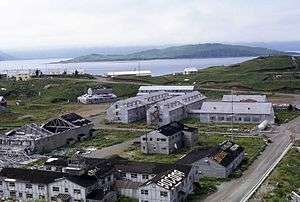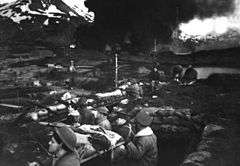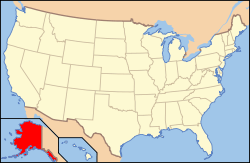Dutch Harbor Naval Operating Base and Fort Mears, U.S. Army
|
Dutch Harbor Naval Operating Base and Fort Mears, U.S. Army | |
|
Japanese attack on Dutch Harbor, June 3, 1942. Group of Marines on the alert between attacks | |
 | |
| Location | Dutch Harbor, Unalaska, Alaska |
|---|---|
| Coordinates | 53°54′6″N 166°31′55″W / 53.90167°N 166.53194°WCoordinates: 53°54′6″N 166°31′55″W / 53.90167°N 166.53194°W |
| Area | 1,000 acres (400 ha) |
| Built | 1940 |
| NRHP Reference # | 85002733 |
| Significant dates | |
| Added to NRHP | February 4, 1985[1] |
| Designated NHLD | February 4, 1985[2] |
The Dutch Harbor Naval Operating Base and Fort Mears are the two military installations built next to each other in Dutch Harbor, on Amaknak Island of the Aleutian Islands in Alaska, by the United States in response to the growing war threat with Imperial Japan. In 1938 the Navy Board recommended the construction which began in July 1940.[3] The first army troops arrived in June 1941 and the navy air base was finished in September 1941. At the time of the attack on Pearl Harbor, these were the only military installations in the Aleutian Islands.
Description
Dutch Harbor occupies the central portion of Amaknak Island, a small island in Unalaska Bay which is separated from the larger Unalaska Island by Iliuliuk Bay. The two islands are joined (and were in the 1940s) joined by a bridge connecting the city of Unalaska to the southern portion of Amaknak Island. During World War II the entirety of Amaknak Island was used by the United States Navy as an operating base, and by the United States Army, which manned coastal defenses on the high ground at the northern and southern parts of the island. The central portion of the island was occupied by the facilities of the naval base, which included a runway and other aircraft support facilities, munitions storage facilities, barracks, a hospital, and a bomb-proof power plant. South of the naval base was Fort Mears, a tribute to Frederick Mears which primarily consisted of barracks for the troops manning the coastal defenses. The coastal defenses included batteries placed to the north on Ulakta Head and Mount Ballyhoo, and to the south on what the army called Hill 400, but is now known as Bunker Hill for its surviving structures.[4]
Battle of Dutch Harbor
On June 3, 1942, the Japanese Navy attacked Dutch Harbor. Originally planned to start at the same time as the battle of Midway, it occurred a day earlier due to one-day delay in the sailing of Nagumo's task force.[5] 43 Americans and at least one Japanese died during the attacks, which lasted for two days. The base remained an important part of coastal defenses for the remainder of World War II.[2]
Postwar

Shortly after the end of World War II, the US military abandoned their Dutch Harbor outposts. For decades afterwards, the buildings remained standing, generally abandoned. With the growth of the king crab fishery in the 1970s, many of these buildings were used as warehouses, bunkhouses, and family homes. In the late 1980s, the US government finally funded a cleanup of the derelict fort, and the area was turned over for commercial use.
See also
- Aleutian World War II National Historic Area
- List of National Historic Landmarks in Alaska
- National Register of Historic Places listings in Aleutians West Census Area, Alaska
References
- ↑ National Park Service (2008-04-15). "National Register Information System". National Register of Historic Places. National Park Service.
- 1 2 "Dutch Harbor Naval Operating Base and Fort Mears, U.S. Army". National Historic Landmark summary listing. National Park Service. Retrieved 2008-07-03.
- ↑ NPS Aviation History
- ↑ "NHL nomination for Dutch Harbor Naval Operating Base and Fort Mears, U.S. Army" (PDF). National Park Service. Retrieved 2014-11-01.
- ↑ Parshall and Tully, Shattered Sword, pp. 43–45, derived from Senshi Sōshō, pp. 119–121.
External links
| Wikimedia Commons has media related to Dutch Harbor Naval Operating Base and Fort Mears. |
- Historic American Buildings Survey (HABS) No. AK-34, "Naval Operating Base Dutch Harbor & Fort Mears, Unalaska, Aleutian Islands, AK", 5 photos, 1 color transparency, 7 measured drawings, 47 data pages, 2 photo caption pages
- Gallery of Dutch Harbor base


